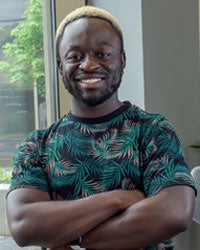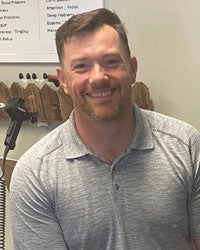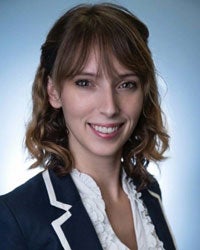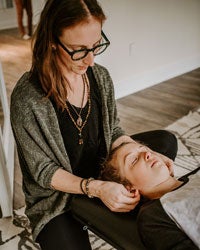Palmer College reaches out to new patients as it ushers in the next generation of chiropractors
Fifty million people in the U.S. see a chiropractor each year, and with a population of 334 million, there are millions of Americans who aren’t accessing this vital health care option.
 Palmer Main Campus student Michael Agyei is driven to reach a new and underserved groups of people after he graduates. He plans to move to Miami, Florida, first to be an associate, then to open his own practice where he hopes to care for a large immigrant population.
Palmer Main Campus student Michael Agyei is driven to reach a new and underserved groups of people after he graduates. He plans to move to Miami, Florida, first to be an associate, then to open his own practice where he hopes to care for a large immigrant population.
“My parents are from Ghana, and I grew up in Denver, Colorado, where there’s a big Ghanian community,” he says. “The model in my community was you only go to the doctor if you’re really sick, and by then, people often needed to take drastic health measures like surgery. Now that I’ve been exposed to chiropractic I can look back and see that lifestyle changes when they were younger could have made a big difference.”
Michael acknowledges that even in communities that are recognized as highly diverse, he doesn’t see a lot of diversity in patient populations. “So how do we break through to really make sure that ‘chiropractic can be for everyone’?” he asks. “Having more people who look like and are similar to a more diverse patient base is a start, but something anyone can do is step outside their normal circle of people and connect with them. Even having a health care provider who speaks the same language or who is recognized and trusted in a community can make a difference.”
He quips, “I used to be almost fluent in Spanish and it’s slipped lately. I know I’ll have to sharpen that skill when I move to Miami.”
To take this path will require perseverance — just ask Quinn Will, D.C. (West, ´12), who attended Palmer West with aspirations of returning to his hometown of Tulsa, Oklahoma, to serve the prominent Native American community there.
 Growing up, Dr. Will accessed services from Indian Health Service (IHS), the primary care provider for tribal members. “I knew I had a heart to serve a population,” he says. “Everybody in the world needs chiropractic. It’s vital to our health. Yet no chiropractic care was available through IHS in Oklahoma.”
Growing up, Dr. Will accessed services from Indian Health Service (IHS), the primary care provider for tribal members. “I knew I had a heart to serve a population,” he says. “Everybody in the world needs chiropractic. It’s vital to our health. Yet no chiropractic care was available through IHS in Oklahoma.”
Following graduation, he began work toward his goal to change this. “It took me, with help from my wife, six months to track down the right person to talk to about incorporating chiropractic care within IHS. It took another six months to get a meeting with him. Once I got in, the meeting lasted 15 minutes and he agreed to a trial run of one day per week for six months. Within the first six months, I was adjusting 60 to 70 patients a day on my portable table, with a three-week waiting list.”
Now eight years later, Dr. Will works out of IHS two days a week, providing care to approximately 70 patients a day with a four-week waiting period. “People are sick of pills, and they don’t want surgery,” he says. “They’re asking: ‘How do I improve my life?’”
To Michael, Dr. Will gives the advice: “It’s going to be harder than you think, but it’s worth it. The ability to communicate chiropractic in an inspiring and hopeful way — and the ability to lead and direct people — is powerful. Be bold about what we know is true from a chiropractic-philosophy perspective, and go serve your community.”
 Much like Dr. Will, Pamela Sawyer, D.C. (Florida, ’15), felt a deeply personal drive to help people through chiropractic. “I grew up without a lot of money, and I was so awed by the help we got from people. As I got older, I knew I wanted to be able to do that too.”
Much like Dr. Will, Pamela Sawyer, D.C. (Florida, ’15), felt a deeply personal drive to help people through chiropractic. “I grew up without a lot of money, and I was so awed by the help we got from people. As I got older, I knew I wanted to be able to do that too.”
With that desire, Dr. Sawyer, whose patients call her “Mighty Mouse” because she’s petite but powerful in her adjustments, began volunteering her time. Since October 2021, Dr. Sawyer has spent Tuesday mornings — her morning off from her job in a private practice — adjusting survivors of human trafficking and individuals who are recovering from substance abuse.
Yet she wants to do more. Dr. Sawyer left her job to open her own practice, Owlet Family Chiropractic. Through its not-for-profit division, Owlet Rescue, she’s able to care for more people in need. “I thought I might see some obstacles with trust in this community, but I haven’t,” she says. “It’s just so needed. In fact, some of my patients have even helped me by teaching me some of the Spanish I’ve needed to help non–English-speaking patients.”
To Michael, Dr. Sawyer says: “Definitely do it. We need more people to spread the word, and I hope more young people will follow in your footsteps.”
Brit Finkbeiner, D.C. (Main, ‘18) came to Palmer with a background in mental health care and training in trauma-informed care. She acknowledges that “our bodies store all of our unique experiences, and being marginalized is a stored trauma.”
Dr. Finkbeiner, who serves the LGBTQ+ community, says that “providing opportunity for a diverse body of people to become chiropractors is how we can serve a broader population. Representation matters, and it empowers the concept that chiropractic is for everyone. People feel safer when they go to someone who understands them and feels that they aren’t being judged.
 “My queerness has defined my entire approach to chiropractic,” Dr. Finkbeiner adds. “Being queer means to question my role in society and to be critical of the status quo. That critical, questioning nature is very much in line with chiropractic. It takes a lot to recognize the limits of your own understanding,” she explains. “We’re very intentional about our words in my office and try not to make assumptions about anything. For example, our paperwork asks for preferred pronouns, and instead of asking for the names of mother and father, it asks for names of parent one and parent two.”
“My queerness has defined my entire approach to chiropractic,” Dr. Finkbeiner adds. “Being queer means to question my role in society and to be critical of the status quo. That critical, questioning nature is very much in line with chiropractic. It takes a lot to recognize the limits of your own understanding,” she explains. “We’re very intentional about our words in my office and try not to make assumptions about anything. For example, our paperwork asks for preferred pronouns, and instead of asking for the names of mother and father, it asks for names of parent one and parent two.”
To Michael, Dr. Brit says: “The more you can hold the simultaneous truth that just because society might marginalize an individual doesn’t mean they’re innately marginalized. Stay connected to that trust. We’re all innately worthy of true health.”
As Palmer College continues to grow the chiropractic profession over the next 125 years, we’re called upon to fulfill the commitment that started with D.D. Palmer: to usher in a world of unlimited health and human potential. To make chiropractic care accessible to all, it’s the College’s charge to think differently about how to reach new patients and the next generation of chiropractors. As a collective of the world’s best chiropractors, that shared knowledge and experience guides the College in how we make these aspirations a reality.
 Palmer Main Campus student Michael Agyei is driven to reach a new and underserved groups of people after he graduates. He plans to move to Miami, Florida, first to be an associate, then to open his own practice where he hopes to care for a large immigrant population.
Palmer Main Campus student Michael Agyei is driven to reach a new and underserved groups of people after he graduates. He plans to move to Miami, Florida, first to be an associate, then to open his own practice where he hopes to care for a large immigrant population. Growing up, Dr. Will accessed services from Indian Health Service (IHS), the primary care provider for tribal members. “I knew I had a heart to serve a population,” he says. “Everybody in the world needs chiropractic. It’s vital to our health. Yet no chiropractic care was available through IHS in Oklahoma.”
Growing up, Dr. Will accessed services from Indian Health Service (IHS), the primary care provider for tribal members. “I knew I had a heart to serve a population,” he says. “Everybody in the world needs chiropractic. It’s vital to our health. Yet no chiropractic care was available through IHS in Oklahoma.” Much like Dr. Will, Pamela Sawyer, D.C. (Florida, ’15), felt a deeply personal drive to help people through chiropractic. “I grew up without a lot of money, and I was so awed by the help we got from people. As I got older, I knew I wanted to be able to do that too.”
Much like Dr. Will, Pamela Sawyer, D.C. (Florida, ’15), felt a deeply personal drive to help people through chiropractic. “I grew up without a lot of money, and I was so awed by the help we got from people. As I got older, I knew I wanted to be able to do that too.” “My queerness has defined my entire approach to chiropractic,” Dr. Finkbeiner adds. “Being queer means to question my role in society and to be critical of the status quo. That critical, questioning nature is very much in line with chiropractic. It takes a lot to recognize the limits of your own understanding,” she explains. “We’re very intentional about our words in my office and try not to make assumptions about anything. For example, our paperwork asks for preferred pronouns, and instead of asking for the names of mother and father, it asks for names of parent one and parent two.”
“My queerness has defined my entire approach to chiropractic,” Dr. Finkbeiner adds. “Being queer means to question my role in society and to be critical of the status quo. That critical, questioning nature is very much in line with chiropractic. It takes a lot to recognize the limits of your own understanding,” she explains. “We’re very intentional about our words in my office and try not to make assumptions about anything. For example, our paperwork asks for preferred pronouns, and instead of asking for the names of mother and father, it asks for names of parent one and parent two.”